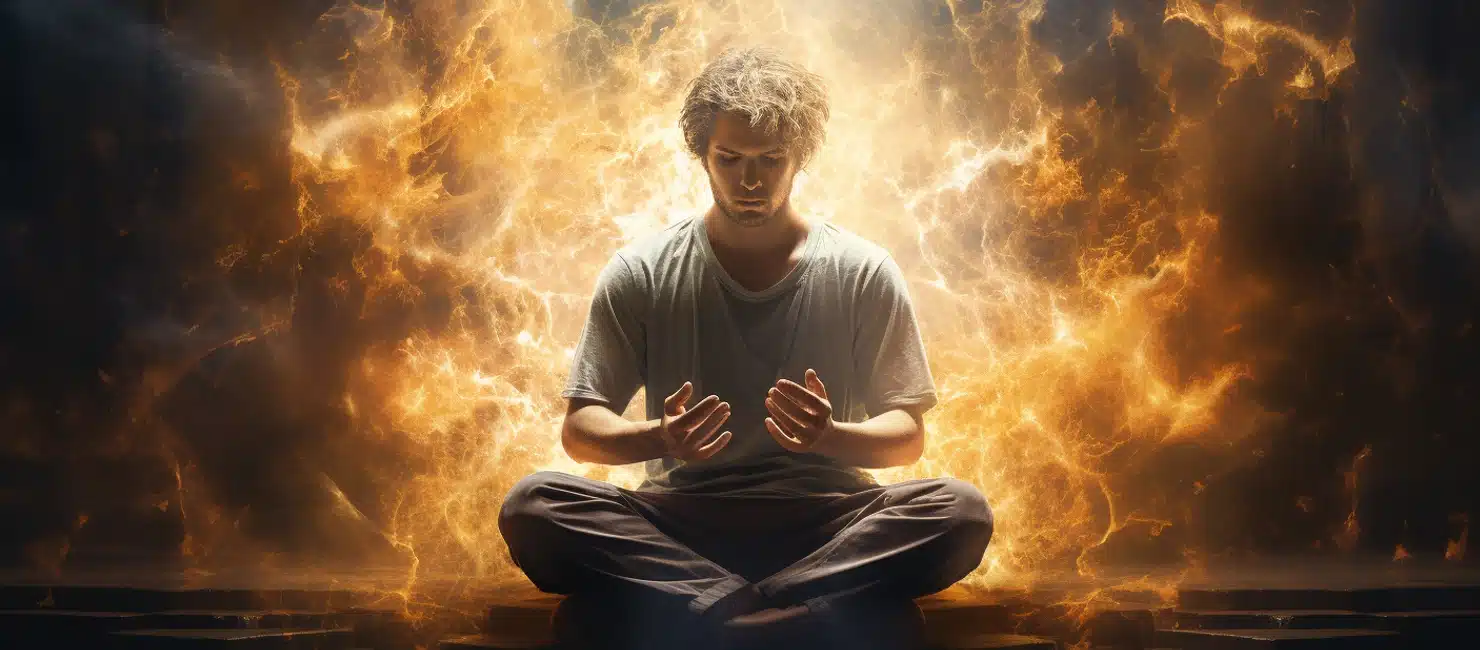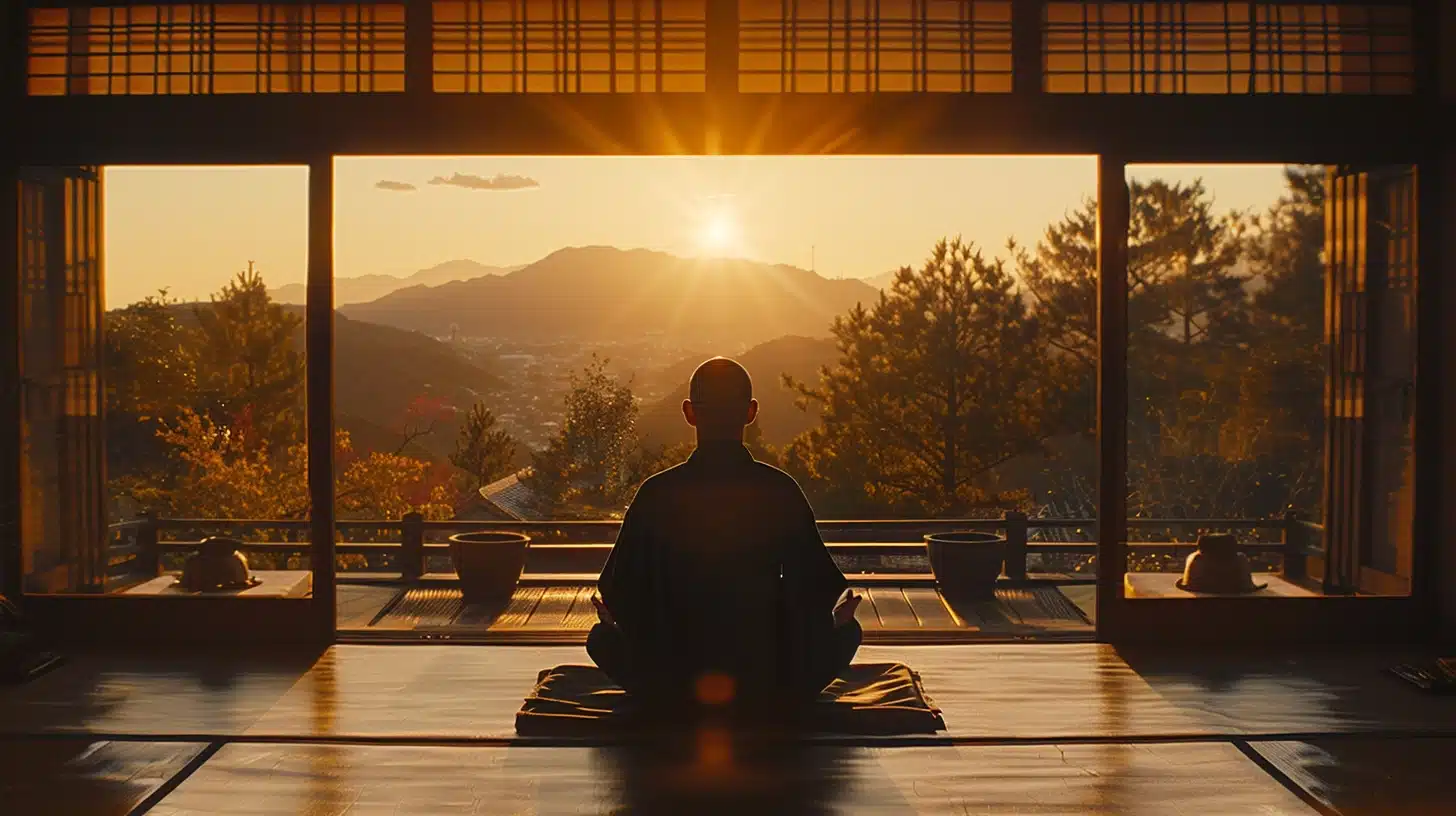Have you noticed odd, involuntary movement during meditation? This phenomenon is not uncommon and can be a source of confusion for many. In this post, we’ll unpack seven types of these involuntary actions that may occur during your meditation practice and what they might mean.
Hang in there; understanding these could lead to deeper insights into your meditative journey.
Practicing body scan meditation for a few days can help you avoid these involuntary movements by helping release the stress stored in the body.

Unleash Your True Potential!
Explore the world of meditation with our powerful guided sessions crafted to bring peace and strength to your spirit.
But first, let’s ensure our sessions are the perfect fit for you.
Take our short quiz to find out!
Table of contents
What Are Involuntary Movements In Meditation
Involuntary movements during meditation are instinctive physical actions that occur without conscious effort or control.
Spontaneous movements during meditation are physical sensations or actions that happen without your conscious control, such as swaying, twitching, or trembling.
Types of involuntary movements in meditation
Not all body moves are on purpose during meditation. Many times, there are actions that just happen. This is what we call ‘involuntary movements.’ Here are some of the types:
- Shaking: Your body might begin to shake or tremble.
- Head Movement: You might find your head nodding or shaking without you telling it to.
- Twitches: Small, jerk-like motions can take place in your limbs.
- Circular Movements: Your body may move in circles or swaying back and forth.
- Swaying: This is rocking back and forth or side to side.
- Floating Hands: Your hands might lift off your legs without any effort from you.
- Body Jolts: You could feel a sudden and quick jerk in your body parts.
- Clockwise Rotation: Your upper body may turn to the right on its own.
7 Most Common Involuntary Movements In Meditation

There are many common involuntary movements that can happen during meditation. Let’s take a deeper look at what these are and why they happen.
For example, shaking during meditation can indicate the release of built-up tension and stress. Read more to understand its significance.
Shaking during meditation
During meditation, you may experience shaking or tremors in your body. This could be a result of the release of tension and energy that arises during the practice. It is not uncommon for meditators to feel their muscles contracting and relaxing involuntarily, leading to shaking sensations.
This movement can also be connected to the activation of dormant energy within the body or what is known as Kundalini awakening. While it may startle you at first, try to embrace these movements as part of your meditation journey rather than resisting them.
Twitching during meditation
Twitching during meditation is a common sensation that many people experience. It’s when your muscles make small, involuntary movements or twitches while you’re in a deep state of relaxation.
This can happen because your body is releasing built-up tension or stress. Sometimes, these twitches are associated with Kundalini-related experiences, which involve the flow of energy through the body.
It might feel strange at first, but it’s actually a sign that you’re becoming more connected with your somatic domain and allowing energy to move freely within you. So don’t worry if you start twitching during meditation – it’s just part of the process!
Eyes twitching during meditation
Eye twitching during meditation is a common phenomenon experienced by many practitioners. This involuntary movement occurs when the muscles around the eyes spasm or contract uncontrollably.
It can be caused by overstimulation, which leads to these muscle contractions. Some individuals may also experience rapid eye movement during meditation. While eye twitching might feel distracting or uncomfortable, it is important to remember that it is a normal part of the meditation process for some people.
Swaying during meditation
Swaying during meditation is a common involuntary movement that can happen. This swaying motion is often linked to the Kundalini energy rising up the spine. It may also be an initial indication of negative energy beings or demons present during meditation.
The spiritual meaning behind swaying varies for each individual, and it’s important to focus deeply on the experience to understand its significance. Other common involuntary movements during meditation include shaking, head movements, and twitches.
Itching during meditation
Itching during meditation is a common experience that many people encounter. It happens because the brain activates certain areas related to itch processing, along with emotional responses.
The physical sensations felt during meditation, like tingling or nausea, are also normal. Traditional spiritual literature even mentions these occurrences during meditation practice.
The itching sensation can have different meanings and interpretations for each individual, so it’s essential to observe and explore these experiences without judgment or attachment.
Yawning during meditation
Yawning during meditation is a common experience that many people have. It’s one of the involuntary movements that can happen when you’re trying to meditate. Yawning during meditation is actually a good sign, because it means your body is relaxed and releasing tension.
When you yawn, your body is entering a more relaxed state and your mind can enter a different level of consciousness. So if you find yourself yawning during meditation, there’s no need to worry – it’s completely normal!
Spontaneous body postures
During meditation, you may also experience spontaneous body postures. These are involuntary movements that can include hand gestures, body twists or turns, and even sitting or lying down in unexpected positions.
These postures can be unique to each individual and may hold personal significance. They are often seen as a natural part of the meditative process and can be linked to the flow of energy within your body.
So, if you find yourself moving into different postures while meditating, embrace it as part of your journey towards inner peace and self-discovery. Seek guidance from a teacher who can help you understand these movements better.
Why do body movement occur during meditation?

Movements pop up during meditation for a few reasons. Energy currents and tension might be in your body. They can show as these moves. You may also learn stuff about yourself by the way you move.
Some people call this kriya, which is just another word for it. Trust, faith, and letting go are big parts here too. Let’s say you do yoga with lots of trust and a heart that’s wide open to what could happen next.
This could lead to the movements happening more often. Muscle activity can also be random and not under your control when you meditate.
The Meaning Behind Involuntary Movements
Involuntary movements during meditation, such as shaking, twitching, and swaying, have deeper meanings related to energy flow, release of pressure and tension, and connecting with the somatic domain.
Kriyas and their significance
Kriyas are sudden movements that happen during meditation. They show a strong spiritual awakening is going on inside your body. These might feel like muscle spasms or jerks while meditating.
This happens because energy is making new paths in your body.
This energy, called kundalini, wakes up during meditation and causes Kriyas. Don’t worry if this makes you move in strange ways! It’s normal and even good for you. Over time, as your body opens more pathways for the energy, these sudden moves will get less frequent and powerful.
Energy flow and release
During meditation, involuntary movements can be tied to the release of tension and increased flow of energy in the body. These movements are believed to correspond with the activation and movement of energy through different energy centers or chakras.
Buddhist practitioners view these movements as kriyas, which are seen as a way for the body to release stored physical and emotional tensions. The flow of energy during meditation can lead to muscle contractions, twitching, shaking, swaying, itching, yawning or even spontaneous body postures.
Embracing these experiences allows for a deeper connection with the somatic domain and can enhance the meditative state.
Pressure and tension release
During meditation, you may experience involuntary movements as a way for your body to release pressure and tension. These movements are often accompanied by positive feelings and an increase in energy.
Sometimes, when we feel stressed or anxious, our bodies hold onto this tension, which can lead to various health problems. But through meditation, we can let go of that pressure and tension, allowing our bodies to relax and find balance.
It’s important to remember that these movements are natural and are part of the process of releasing stress from our bodies during meditation.
Connecting with the somatic domain
During meditation, you have the opportunity to connect with your somatic domain, which involves changes in your body’s functioning and physical processes. It allows you to observe how your body responds and reacts during this practice.
In a study on involuntary movements during meditation, researchers found that these movements often coincide with other physiological changes in the somatic domain. For example, many practitioners report feeling vibrations throughout their bodies while meditating.
This experience is believed to be connected to various other somatic sensations that may arise during meditation. By paying attention to these bodily changes, you can deepen your awareness of yourself and enhance your overall meditative experience.
Connecting with the somatic domain allows you to explore the different ways in which your body communicates with you during meditation. It helps you understand that these involuntary movements are not random or meaningless but rather hold significance within the context of your practice.
By staying present and receptive to what arises in your body, you can learn more about its energy flow, release tension or pressure held within it, and gain insights into any kriyas (spontaneous movements) that may occur.

Unleash Your True Potential!
Explore the world of meditation with our powerful guided sessions crafted to bring peace and strength to your spirit.
But first, let’s ensure our sessions are the perfect fit for you.
Take our short quiz to find out!
Coping with Involuntary Movements
To cope with involuntary movements during meditation, embrace the experience and seek guidance from a teacher to differentiate between these movements and physical ailments.

Embracing the experience
Involuntary movements during meditation can be a bit surprising and sometimes uncomfortable. However, it’s important to embrace these experiences rather than resisting or being anxious about them.
These movements are often a natural part of the meditation process and can have deeper meanings associated with energy flow, release of pressure and tension, and connecting with our body on a somatic level.
By accepting and allowing these movements to happen without judgment or fear, we can deepen our practice and gain insights into ourselves. Seeking guidance from an experienced teacher can also provide valuable support in understanding and navigating through these experiences.
Seeking guidance from a teacher
If you experience involuntary movements during meditation, seeking guidance from a teacher can be really helpful. A teacher or guide who has knowledge about these movements can provide support and help you understand what they mean.
They can offer techniques to cope with the movements and give you reassurance that they are normal and part of the process. Having someone experienced to talk to can also help differentiate between involuntary movements and physical ailments, ensuring that you take care of yourself in the best way possible while meditating.
It’s important to have proper guidance when dealing with these experiences so that you can have a safe and beneficial meditation practice.
Differentiating between involuntary movements and physical ailments
Differentiating between involuntary movements and physical ailments is important during meditation. Involuntary movements are spontaneous muscle activities that can occur while meditating.
They may include shaking, twitching, swaying, or even yawning. These movements are generally harmless and can be attributed to the release of tension or energy flow in the body. On the other hand, physical ailments refer to any discomfort or pain that is unrelated to the natural process of meditation.
It’s crucial to recognize the difference between these two so that you can address any underlying health issues separately from your meditation practice. Seeking guidance from a teacher and being mindful of your own sensations can help you differentiate between involuntary movements and physical ailments during meditation.
Learn to Meditate: 5 Essential Keys to Meditation
Learning the proper meditation techniques are also very important in order to avoid any involuntary body movements. If you have guru or teacher you can learn from, then great. In case you don’t, you can try a spiritual meditation app, such as Enhanced.
- Type of meditation: if you are practicing a spiritual meditation, for example, astral projection or tantric meditation then you also need to learn about it. There are many details, such as understanding the difference between the subtle body and the physical body.
- Mastering the technique: practice and consistency are essential for mastering anything. When you are achieving deep meditation stages and your body and mind are in sync, that’s when you’ve mastered the technique. This means This means calmer mind and calmer body.
- Begin with easier forms of meditation: focus on breathing or focus on the point between the eyebrows. Feel your energy surging in the upward movement. Occasionally, you may also experience in meditation that your body starts moving. Stick to pranayam if that happens for some time.
- Use guided meditation: When you are able to let go and just focus on a voice, it will be easier to meditate. It will allow you to experience deeper relaxation and stillness which will help avoid any unwanted movements of the body.
- Yogic meditation: yoga practices and slow meditative movements of yoga can also help you release any stored energy in the body. You will be able to release stored energy and meditate with more stillness by meditating after yoga practice.
Conclusion
In conclusion, involuntary movements during meditation can be a normal and meaningful experience. These movements, known as kriyas, signify energy flow and release in the body. It is important to embrace these experiences without overanalyzing them, seeking guidance from a teacher if needed.
Remember that these movements are part of your journey towards deeper connection with yourself and the somatic domain. So trust the process, surrender, and let go. Happy meditating!
FAQs
Why do involuntary movements occur during meditation?
Involuntary movements can occur during meditation due to the release of tension, energy flow in the body, or deep relaxation of muscles and nerves.
Are involuntary movements normal during meditation?
Yes, involuntary movements can be a normal part of the meditative process for some individuals. They may indicate that you are entering a deeply relaxed state or experiencing a shift in your energy.
Should I be concerned about experiencing involuntary movements during meditation?
No, there is usually no need for concern if you experience involuntary movements during meditation. It’s important to stay present and allow them to naturally unfold without resisting or forcing them.
What do the different types of involuntary movements mean?
The meaning behind specific types of involuntary movement can vary. For example, swaying may indicate relaxation and balance while twitching could signify the release of nervous energy. It’s best to observe these experiences without judgment and seek guidance from an experienced meditator if needed.










